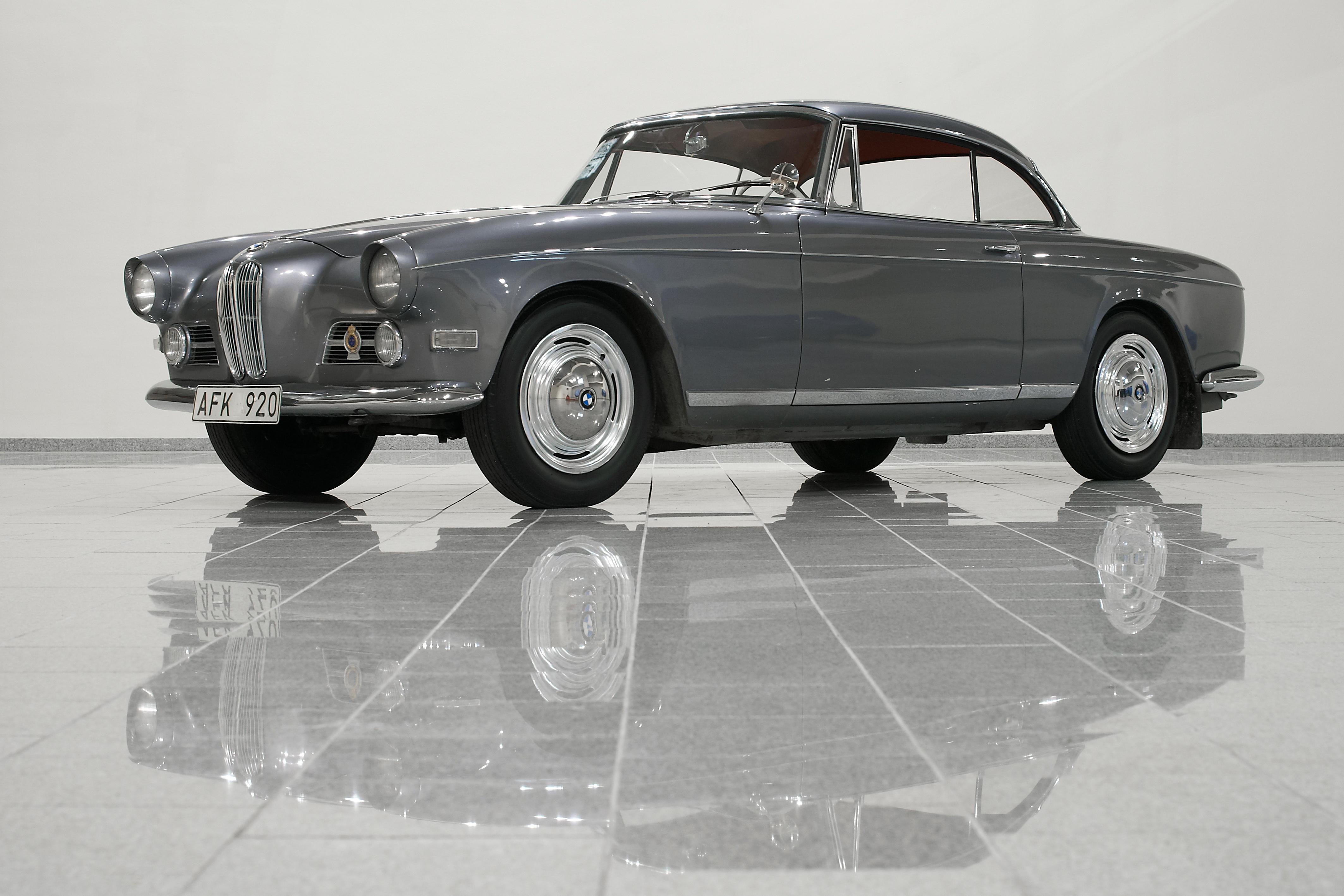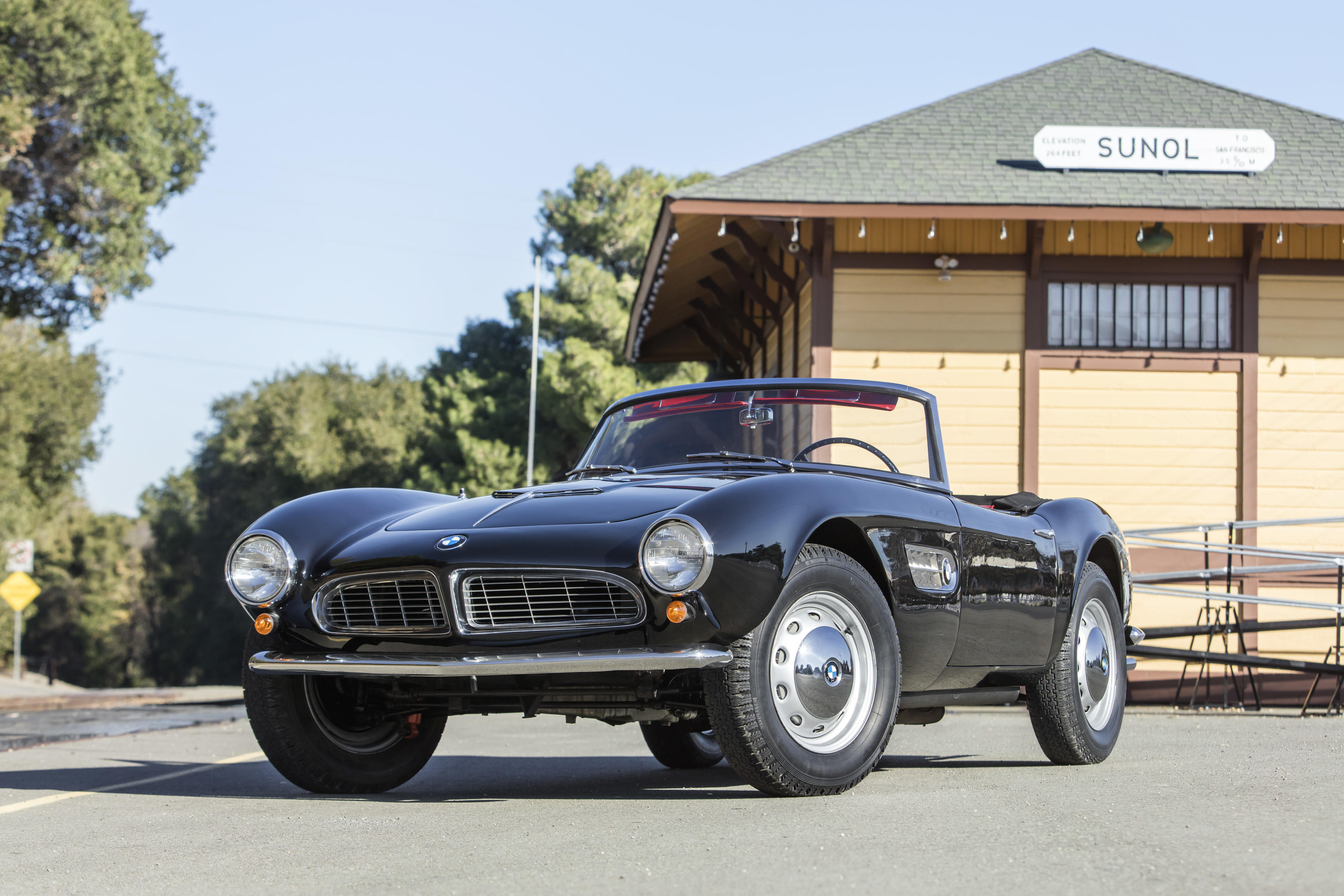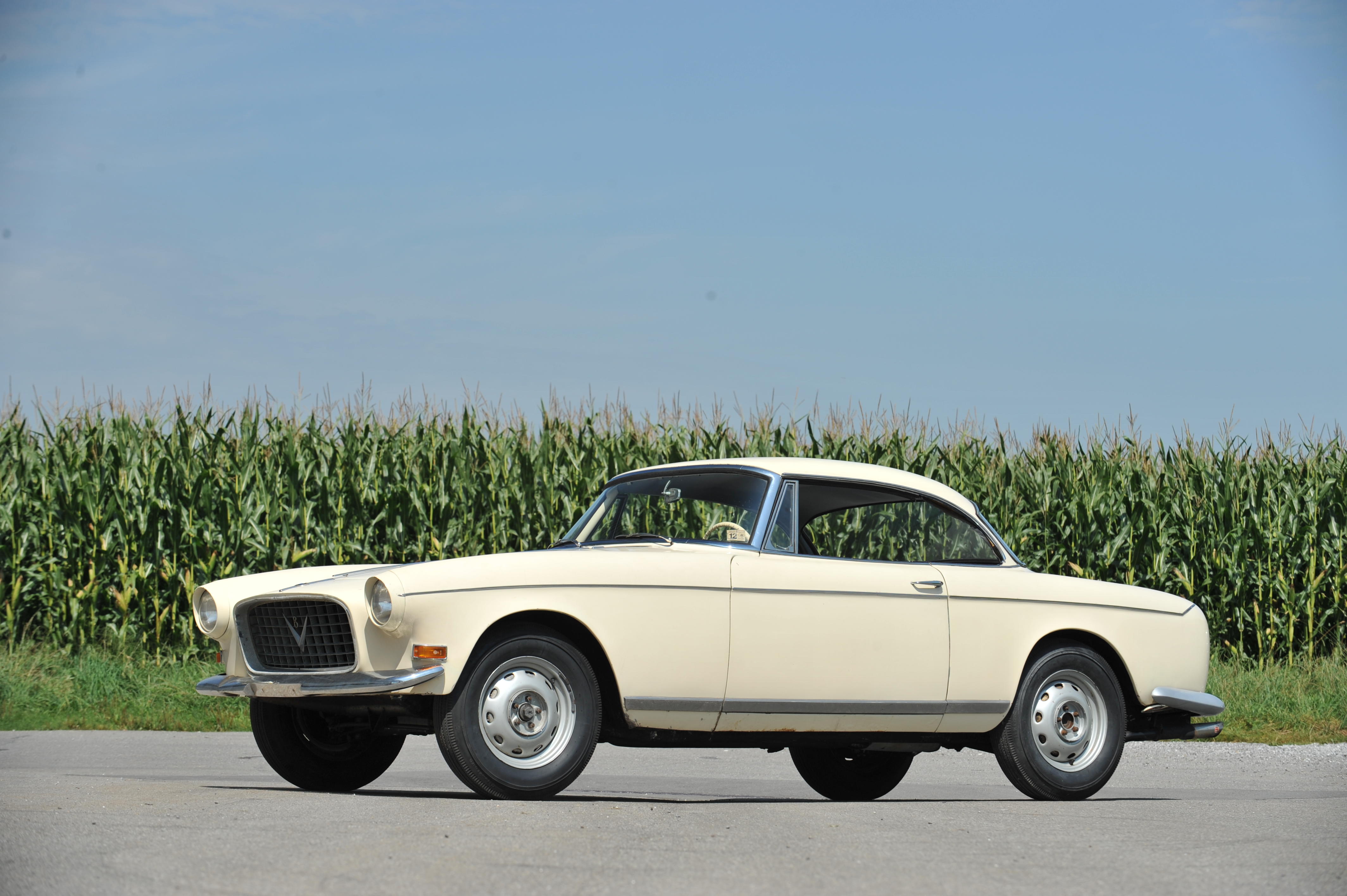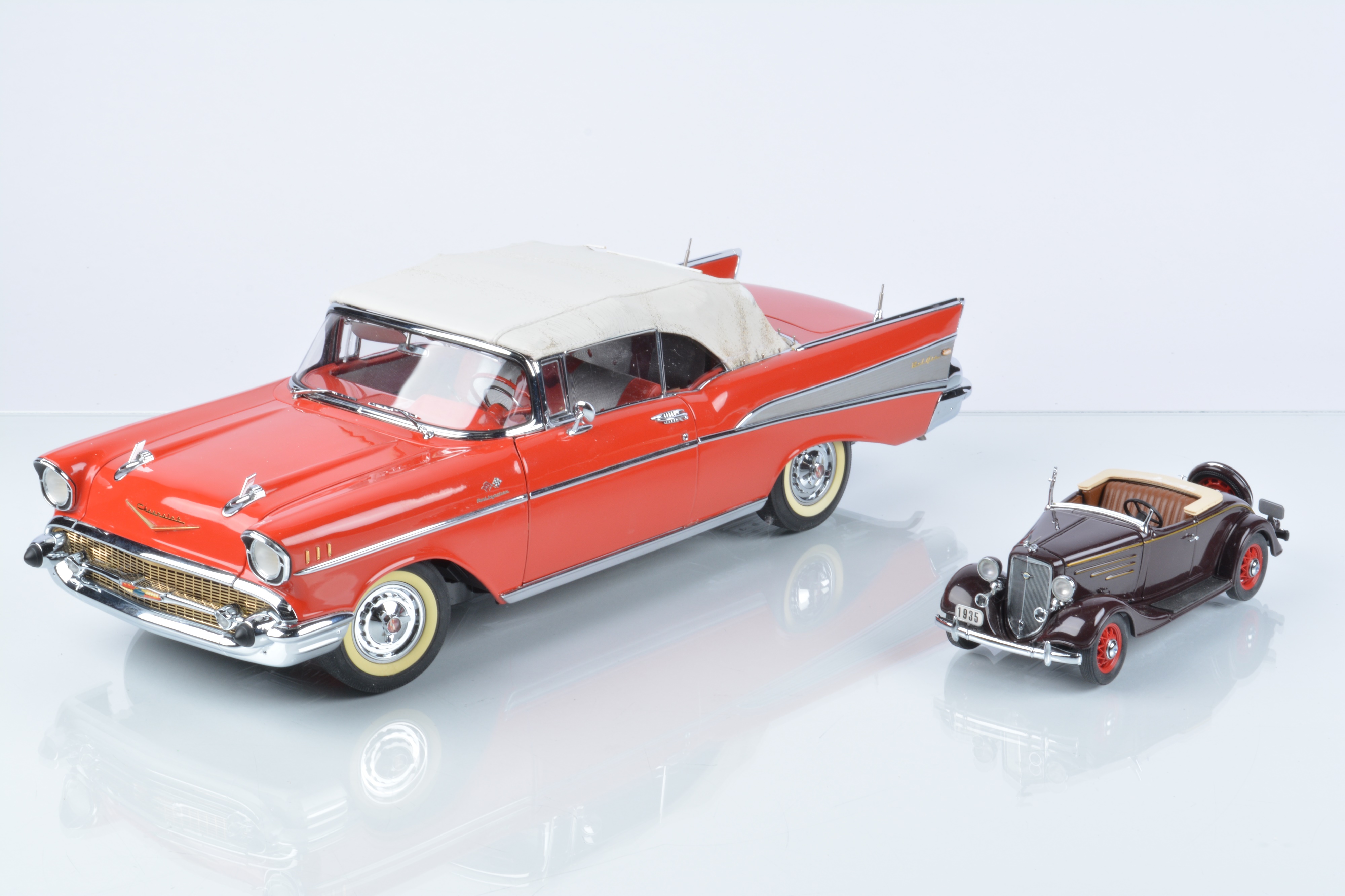3,168cc OHV All-Alloy V8 Engine
2 Twin-choke Zenith Carburetors
150bhp at 5,000rpm
4-Speed ZF Manual Transmission
Independent Front Suspension – Live Rear Axle
4-Wheel Hydraulic Aluminum Drum Brakes
*Numbers matching example
*Delivered new to Venezuela
*In present ownership for over four decades
*One of only 253 BMW 507s built
THE BMW 507
During the 1950s, car designers on both sides of the Atlantic produced some of the all-time greats of automotive styling, none of them more classically beautiful than the sublime BMW 507. Indeed, a measure of the 507's iconic significance may be discerned from BMW's 're-introduction' of the model, after a gap of 40 years, in the form of the Z8 roadster. In an age when it has become de rigeur for heritage-conscious motor manufacturers to incorporate styling cues from landmark models into their latest offerings, few have ventured as far as BMW in paying homage to a recognized Classic.
Transatlantic in inspiration - aimed at the United States market, styled by a New York-domiciled German ex-patriot and built in Germany - the 507 reflected North American taste yet was unmistakably European in origin. The 507 saga began in 1954, when Austrian-born entrepreneur Max Hoffman, at that time the US importer of various European makes, convinced BMW that if they built a sports car to rival
Mercedes-Benz's successful 300 SL, he could sell sufficient numbers in the United States to make the project viable.
Hoffman knew just the man to style the car too: Count Albrecht von Goertz, an independent industrial designer who had worked for the legendary Raymond Loewy on the latter's trend-setting Studebakers. Designer of everything from fountain pens to furniture, Goertz had never before styled an entire car, and after the 507, would not work for BMW again until the 1980s.
The fundamental elements of BMW's proposed new sports car already existed in the 502 saloon, most notably its 3.2-liter, all-aluminum V8 engine, which was installed in a shortened chassis for the 507. Mechanical design was handled by BMW stalwarts Fritz Fiedler and Alex von Falkenhausen, with Goertz shuttling back and forth between the USA and Germany to oversee production of the full-size clay model. The robust nature of the 502-based chassis necessitated the use of aluminum for the 507's bodywork in the interest of weight saving, the finished car tipping the scales at around 1,280kg. With 150bhp on tap, performance was adequate if not stunning, production cars being capable of around 200km/h (125mph), with 100km/h (62mph) coming up in 11 seconds. For relaxed cruising though, the 507 had few peers, its state-of-the-art V8 engine delivering ample torque over a wide rev range.
Although the prototype displayed at the 1955 Frankfurt Auto Show met with critical acclaim, the 507's reception at its New York debut two months earlier had been disappointing. BMW had missed Hoffman's $5,000 price target by a wide margin, the 507's initial US selling price being set at $9,000, more than double the cost of a Ford Thunderbird or Chevrolet Corvette. In the UK, one could buy two Jaguar XK150s for the price of a single 507. Even Mercedes-Benz's 300 SL Coupé was cheaper, though the Stuttgart firm was sufficiently impressed (worried?) by the 507 to introduce a direct competitor in the form of the 300 SL Roadster.
Production proper of the 507 did not begin until 1956, the first series being built until June 1957 when the design was revised in detail. Improvements were mainly concentrated on the interior, which gained a deeper dashboard, a greater range of fore-and-aft seat adjustment, and a rear parcel shelf. There was, almost inevitably, an increase in price that only served to place the 507 even further beyond the reach of ordinary mortals. For those who could afford style at any price, however, BMW's svelte roadster was the car to be seen in: pop idol Elvis Presley, motorcycling World Champion John Surtees film stars Alain Delon, David Carradine and Ursula Andress, skiing champion Toni Sailer, Prince Rainer of Monaco, King Constantine II of Greece and the Aga Khan all being owners at one time or another. Nevertheless, such a limited clientele, however exclusive, could not sustain the 507 in production, which ceased in December 1959 after only 253 cars had been sold.
THE MOTORCAR OFFERED
Every BMW 507 is a special machine, but the example benefits from both enthusiast long term owners and beautiful preservation as a result of long-term dry storage. One of only 252 examples of the 507 ever built, chassis 70059 was one of 13 of these rare and special 507s to be delivered new to Venezuela. According to BMW Classic records and confirmed by BMW V8 Registrar Wolfgang Niefanger, this 507 was finished in Silberblau (silver blue) over matching Silberblau leather and completed on July 19, 1957. It was ordered through Venezuelan BMW importer Eduard Zingg by American expat Lester Stebbins. As a car delivered to a hot climate, it was specially fitted with a Jaguar-sourced radiator fan for improved cooling. Mr. Stebbins, a North Dakota born salesman, had a successful career with the American Circle Company selling chewing gum before moving down to South America shortly after WWII. Settling in Caracas, Venezuela in 1951, he would remain there for the next decade. During his time there, he became involved in motorsport, eventually becoming the Chief Scrutineer and the Director of Automobile Racing of Venezuela. While in this role, Stebbins hosted numerous racing stars, politicians, and celebrities. In 1959, he was part of the Franco-Venezuelan team that raced a Ferrari 250GT to 6th overall at LeMans.
An active purchaser of some of the finest sportscars, Stebbins bought this 507, a relatively early Series II, hot on the heels of acquiring a 300SL Gullwing Coupe and a Ferrari 250GT. Described as his favorite car, shortly after taking delivery of it, he added a small scoop to the cabin vent in front of the windscreen to improve air circulation through the cabin while cruising through hot, humid, Caracas. Pictures of Stebbins with his new 507—as well as with his 300SL—record the car's earliest history including its fitted hardtop and Rudge wheels. During Stebbin's ownership, the car was repainted white.
In 1961, Stebbins was transferred to Toronto, Canada and brought his 507 with him up north. The BMW would remain in Canada for the next 18 years. At some point, Lester Stebbins sold his beloved Bimmer and the 507 would eventually find its way east to Jack Kroch of Ottawa, Canada. In 1979, the Roadster was resprayed Pontiac Bright Blue Metallic—the paint it wears today.
Kroch is understood to have used the car as an exhibition pace car at a vintage car race at Circuit Mont-Tremblant. A member of the BMW 507 enthusiast group, Kroch connected with Philadelphia-based BMW collector Herman Bold through the 507 club. Herman and his brother, Gerhard (who bought the family's first 507, s/n 70228, new from the factory in 1959) were beginning to collect an extensive array of 'spare' 507 components. Herman, keen to acquire Jack Kroch's car, asked that if he were ever to sell the car to let him know. On September 14, 1979, Herman purchased 70059 from Jack for $22,000—a copy of the original bill of sale listing the car by engine and chassis number is included in the file along with a picture of Herman and Jack standing next to the car in Jack's Ontario driveway.
Trailering the car back to his home in Philadelphia, 70059 was stored with the family's other 507s, including 70054 (a green 507 a picture of which shows it parked tail to tail with 70059 around Thanksgiving, 1980) and the burned-out chassis of another 507 acquired from a southern US salvage yard. Additional pictures show the car's earliest documented history in the Bold family's collection. Purchased as a 'spare' 507 in case one of the others were to be incapacitated, 70059 ended up being largely locked away. Properly oiled, started occasionally, and kept away from the elements, the 507 subsequently sat with its sibling undisturbed in a shed attached to a nondescript northwest Philadelphia residence for the next 43 years.
After more than four decades of slumber, this 507 was brought out of its garage—under its own power—for the first time in May of 2022. Showing much as it did when Herman Bold bought it in 1979, the interior has a rich, lived-in feel that can only come from 65 years of sparing use. While the exterior carries its old, Pontiac paint, the hardtop, engine bay, door jambs, floors, and elsewhere continue to wear the original Silberblau with which it left the factory. The engine has remained in the car since new. Rare, original components are present including the Behr radiator, and many Bosch and Knecht ancillary components. A very rare original Blaupunkt Köln radio is fitted in the dash. The Roadster is replete with a largely complete under hood toolkit, owner's handbook and pflegedienstheft (repair service booklet), copies of the Bill of Sale to Herman Bold, paint swatch for the current Pontiac paint color, and photos throughout the history of the car appear on file.
Offered here for the first time since the Carter administration, this spectacular BMW is ready to head to a new home. Whether carefully preserved or fully restored, the next owner can enjoy the car on any number of exclusive events including the Mille Miglia, Colorado Grand, California Mille, and more. The BMW 507, despite its contemporary commercial limitations, proved to be a landmark model for the German manufacturer. Only 253 examples of BMW's now legendary 507 were built. An exceptional and exclusive sports car indeed – much rarer than the 300SL Mercedes-Benz, the 507 with its lithe and utterly beautiful design matched by the impressive sporting pedigree of the Bavarian marque, remains a truly timeless collector car, appreciated by top collectors around the world, and eligible for the world's most discerning collector car events.
3,168cc OHV All-Alloy V8 Engine
2 Twin-choke Zenith Carburetors
150bhp at 5,000rpm
4-Speed ZF Manual Transmission
Independent Front Suspension – Live Rear Axle
4-Wheel Hydraulic Aluminum Drum Brakes
*Numbers matching example
*Delivered new to Venezuela
*In present ownership for over four decades
*One of only 253 BMW 507s built
THE BMW 507
During the 1950s, car designers on both sides of the Atlantic produced some of the all-time greats of automotive styling, none of them more classically beautiful than the sublime BMW 507. Indeed, a measure of the 507's iconic significance may be discerned from BMW's 're-introduction' of the model, after a gap of 40 years, in the form of the Z8 roadster. In an age when it has become de rigeur for heritage-conscious motor manufacturers to incorporate styling cues from landmark models into their latest offerings, few have ventured as far as BMW in paying homage to a recognized Classic.
Transatlantic in inspiration - aimed at the United States market, styled by a New York-domiciled German ex-patriot and built in Germany - the 507 reflected North American taste yet was unmistakably European in origin. The 507 saga began in 1954, when Austrian-born entrepreneur Max Hoffman, at that time the US importer of various European makes, convinced BMW that if they built a sports car to rival
Mercedes-Benz's successful 300 SL, he could sell sufficient numbers in the United States to make the project viable.
Hoffman knew just the man to style the car too: Count Albrecht von Goertz, an independent industrial designer who had worked for the legendary Raymond Loewy on the latter's trend-setting Studebakers. Designer of everything from fountain pens to furniture, Goertz had never before styled an entire car, and after the 507, would not work for BMW again until the 1980s.
The fundamental elements of BMW's proposed new sports car already existed in the 502 saloon, most notably its 3.2-liter, all-aluminum V8 engine, which was installed in a shortened chassis for the 507. Mechanical design was handled by BMW stalwarts Fritz Fiedler and Alex von Falkenhausen, with Goertz shuttling back and forth between the USA and Germany to oversee production of the full-size clay model. The robust nature of the 502-based chassis necessitated the use of aluminum for the 507's bodywork in the interest of weight saving, the finished car tipping the scales at around 1,280kg. With 150bhp on tap, performance was adequate if not stunning, production cars being capable of around 200km/h (125mph), with 100km/h (62mph) coming up in 11 seconds. For relaxed cruising though, the 507 had few peers, its state-of-the-art V8 engine delivering ample torque over a wide rev range.
Although the prototype displayed at the 1955 Frankfurt Auto Show met with critical acclaim, the 507's reception at its New York debut two months earlier had been disappointing. BMW had missed Hoffman's $5,000 price target by a wide margin, the 507's initial US selling price being set at $9,000, more than double the cost of a Ford Thunderbird or Chevrolet Corvette. In the UK, one could buy two Jaguar XK150s for the price of a single 507. Even Mercedes-Benz's 300 SL Coupé was cheaper, though the Stuttgart firm was sufficiently impressed (worried?) by the 507 to introduce a direct competitor in the form of the 300 SL Roadster.
Production proper of the 507 did not begin until 1956, the first series being built until June 1957 when the design was revised in detail. Improvements were mainly concentrated on the interior, which gained a deeper dashboard, a greater range of fore-and-aft seat adjustment, and a rear parcel shelf. There was, almost inevitably, an increase in price that only served to place the 507 even further beyond the reach of ordinary mortals. For those who could afford style at any price, however, BMW's svelte roadster was the car to be seen in: pop idol Elvis Presley, motorcycling World Champion John Surtees film stars Alain Delon, David Carradine and Ursula Andress, skiing champion Toni Sailer, Prince Rainer of Monaco, King Constantine II of Greece and the Aga Khan all being owners at one time or another. Nevertheless, such a limited clientele, however exclusive, could not sustain the 507 in production, which ceased in December 1959 after only 253 cars had been sold.
THE MOTORCAR OFFERED
Every BMW 507 is a special machine, but the example benefits from both enthusiast long term owners and beautiful preservation as a result of long-term dry storage. One of only 252 examples of the 507 ever built, chassis 70059 was one of 13 of these rare and special 507s to be delivered new to Venezuela. According to BMW Classic records and confirmed by BMW V8 Registrar Wolfgang Niefanger, this 507 was finished in Silberblau (silver blue) over matching Silberblau leather and completed on July 19, 1957. It was ordered through Venezuelan BMW importer Eduard Zingg by American expat Lester Stebbins. As a car delivered to a hot climate, it was specially fitted with a Jaguar-sourced radiator fan for improved cooling. Mr. Stebbins, a North Dakota born salesman, had a successful career with the American Circle Company selling chewing gum before moving down to South America shortly after WWII. Settling in Caracas, Venezuela in 1951, he would remain there for the next decade. During his time there, he became involved in motorsport, eventually becoming the Chief Scrutineer and the Director of Automobile Racing of Venezuela. While in this role, Stebbins hosted numerous racing stars, politicians, and celebrities. In 1959, he was part of the Franco-Venezuelan team that raced a Ferrari 250GT to 6th overall at LeMans.
An active purchaser of some of the finest sportscars, Stebbins bought this 507, a relatively early Series II, hot on the heels of acquiring a 300SL Gullwing Coupe and a Ferrari 250GT. Described as his favorite car, shortly after taking delivery of it, he added a small scoop to the cabin vent in front of the windscreen to improve air circulation through the cabin while cruising through hot, humid, Caracas. Pictures of Stebbins with his new 507—as well as with his 300SL—record the car's earliest history including its fitted hardtop and Rudge wheels. During Stebbin's ownership, the car was repainted white.
In 1961, Stebbins was transferred to Toronto, Canada and brought his 507 with him up north. The BMW would remain in Canada for the next 18 years. At some point, Lester Stebbins sold his beloved Bimmer and the 507 would eventually find its way east to Jack Kroch of Ottawa, Canada. In 1979, the Roadster was resprayed Pontiac Bright Blue Metallic—the paint it wears today.
Kroch is understood to have used the car as an exhibition pace car at a vintage car race at Circuit Mont-Tremblant. A member of the BMW 507 enthusiast group, Kroch connected with Philadelphia-based BMW collector Herman Bold through the 507 club. Herman and his brother, Gerhard (who bought the family's first 507, s/n 70228, new from the factory in 1959) were beginning to collect an extensive array of 'spare' 507 components. Herman, keen to acquire Jack Kroch's car, asked that if he were ever to sell the car to let him know. On September 14, 1979, Herman purchased 70059 from Jack for $22,000—a copy of the original bill of sale listing the car by engine and chassis number is included in the file along with a picture of Herman and Jack standing next to the car in Jack's Ontario driveway.
Trailering the car back to his home in Philadelphia, 70059 was stored with the family's other 507s, including 70054 (a green 507 a picture of which shows it parked tail to tail with 70059 around Thanksgiving, 1980) and the burned-out chassis of another 507 acquired from a southern US salvage yard. Additional pictures show the car's earliest documented history in the Bold family's collection. Purchased as a 'spare' 507 in case one of the others were to be incapacitated, 70059 ended up being largely locked away. Properly oiled, started occasionally, and kept away from the elements, the 507 subsequently sat with its sibling undisturbed in a shed attached to a nondescript northwest Philadelphia residence for the next 43 years.
After more than four decades of slumber, this 507 was brought out of its garage—under its own power—for the first time in May of 2022. Showing much as it did when Herman Bold bought it in 1979, the interior has a rich, lived-in feel that can only come from 65 years of sparing use. While the exterior carries its old, Pontiac paint, the hardtop, engine bay, door jambs, floors, and elsewhere continue to wear the original Silberblau with which it left the factory. The engine has remained in the car since new. Rare, original components are present including the Behr radiator, and many Bosch and Knecht ancillary components. A very rare original Blaupunkt Köln radio is fitted in the dash. The Roadster is replete with a largely complete under hood toolkit, owner's handbook and pflegedienstheft (repair service booklet), copies of the Bill of Sale to Herman Bold, paint swatch for the current Pontiac paint color, and photos throughout the history of the car appear on file.
Offered here for the first time since the Carter administration, this spectacular BMW is ready to head to a new home. Whether carefully preserved or fully restored, the next owner can enjoy the car on any number of exclusive events including the Mille Miglia, Colorado Grand, California Mille, and more. The BMW 507, despite its contemporary commercial limitations, proved to be a landmark model for the German manufacturer. Only 253 examples of BMW's now legendary 507 were built. An exceptional and exclusive sports car indeed – much rarer than the 300SL Mercedes-Benz, the 507 with its lithe and utterly beautiful design matched by the impressive sporting pedigree of the Bavarian marque, remains a truly timeless collector car, appreciated by top collectors around the world, and eligible for the world's most discerning collector car events.











Try LotSearch and its premium features for 7 days - without any costs!
Be notified automatically about new items in upcoming auctions.
Create an alert